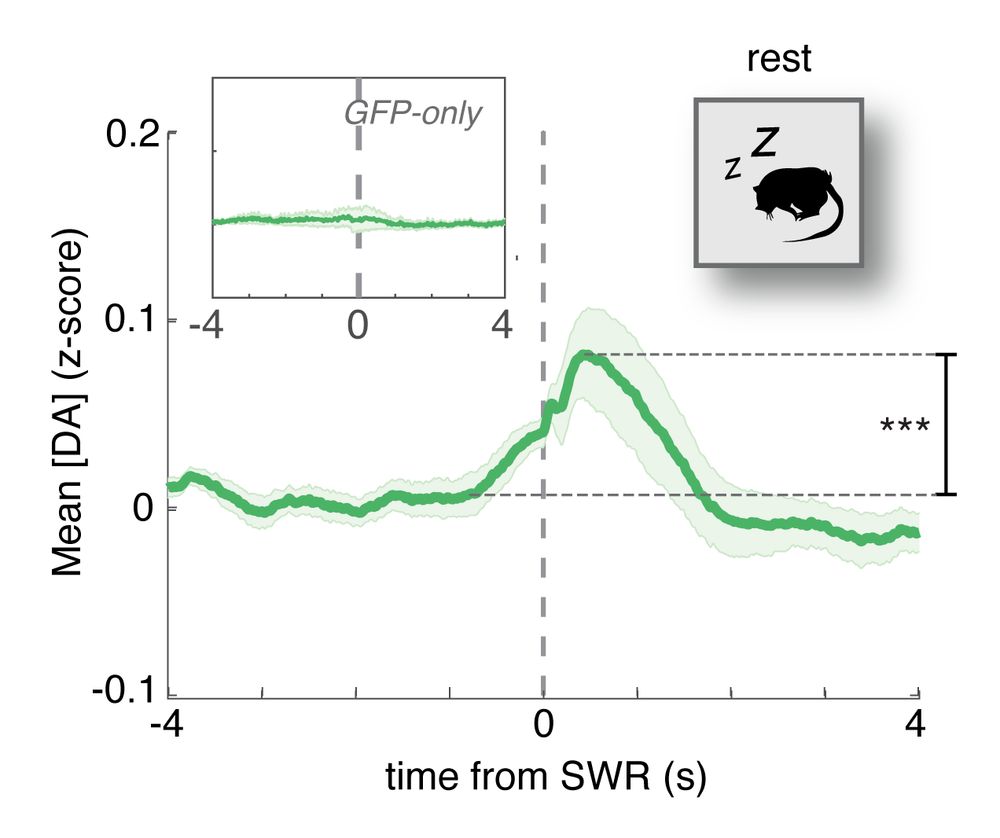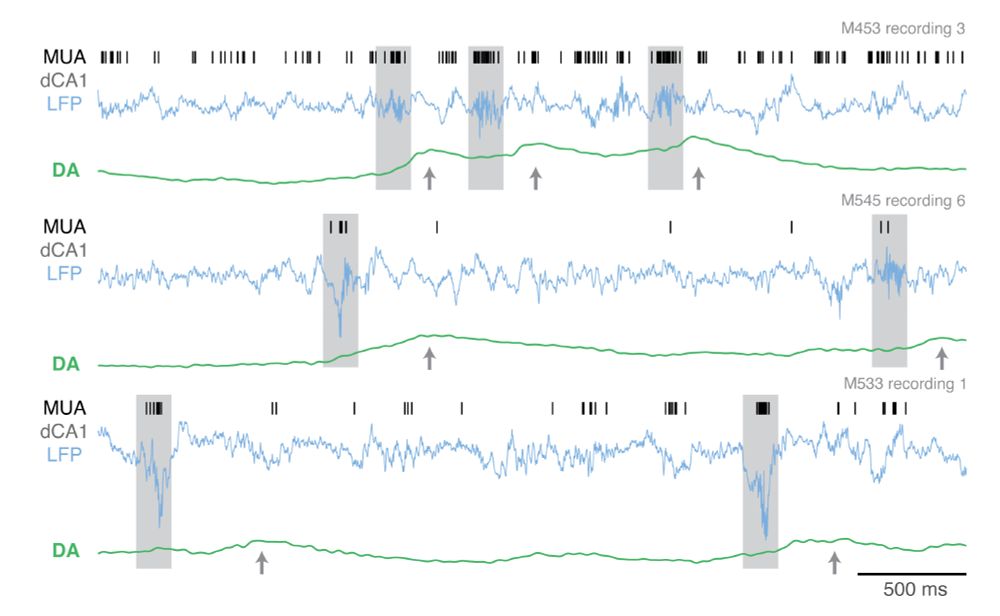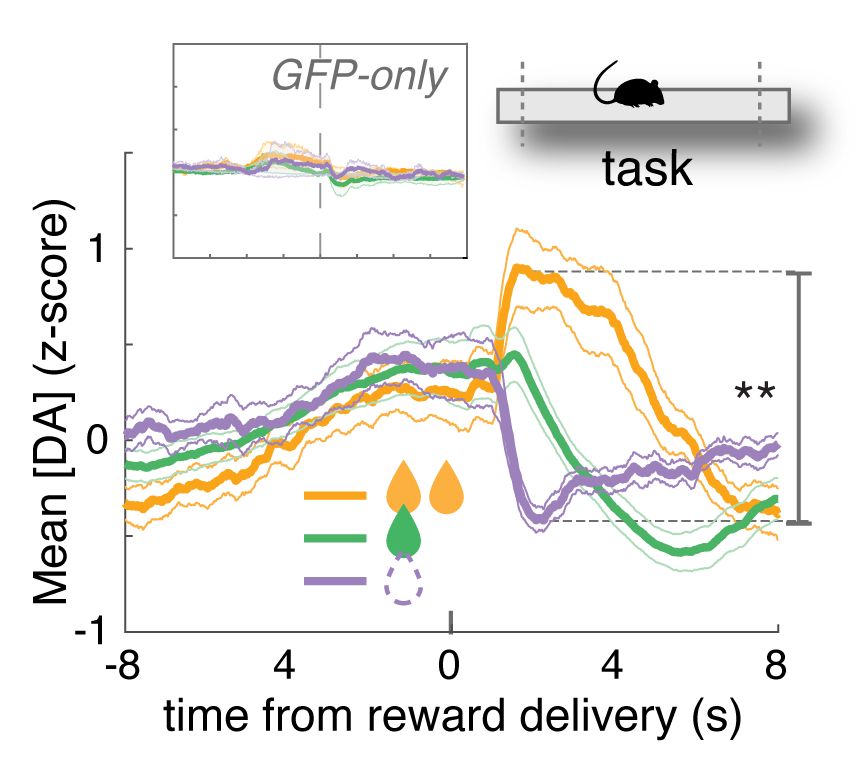We are excited about the next steps, such as determining causality and the circuit mechanisms of SWR-DA coupling, as well as whether replay content of different valences is evaluated differently. :) (9/9)
04.08.2025 18:30 — 👍 1 🔁 0 💬 0 📌 0
Building on earlier findings (Gomperts et al., 2015), our work shows that DAergic transients known to drive learning in response to online experienced events are also present following offline replayed events. (8/9)
04.08.2025 18:30 — 👍 1 🔁 0 💬 1 📌 0
To characterize the SWR-DA, we fit LMMs. We found that the SWR-DA size could not be explained by the differences in track running speed (a proxy for motivation) or by the magnitude of the prediction error coding during the task. (7/9)
04.08.2025 18:30 — 👍 1 🔁 0 💬 1 📌 0

Averaging across all sessions and mice, we found an increase in DA peaking ~0.3 s after SWRs! The SWR-DA transient was about 24% of the size of a putative positive RPE. (6/9)
04.08.2025 18:30 — 👍 1 🔁 0 💬 1 📌 0

Next, during a rest period before or after the task, we found SWR-triggered DA transients (SWR-DA). Here are some examples from three different sessions and mice (MUA: black tick marks; local field potential traces: blue line; GRABDA2m fiber photometry traces: green line). (5/9)
04.08.2025 18:30 — 👍 1 🔁 0 💬 1 📌 0

Consistent with previous work, we found a clear suppression of the dopamine concentration ([DA]) signal following reward omission relative to the expected (medium) amount, and a clear increase in [DA] following larger-than-expected reward. (4/9)
04.08.2025 18:30 — 👍 1 🔁 0 💬 1 📌 0
First, we established what putative VS DA prediction errors look like in our hands by measuring the GRAB-DA signal on a probabilistic reward task. Mice ran on a linear track where rewards of different sizes were delivered at both ends. (3/9)
04.08.2025 18:30 — 👍 0 🔁 0 💬 1 📌 0
Leading computational theories (e.g. Mattar & Daw, 2018) suggest that replayed experiences drive learning via a teaching signal (e.g.prediction errors). To test if this may be true within the brain, we investigated the link between putative dCA1 replay events (SWRs) and VS DA teaching signals. (2/9)
04.08.2025 18:30 — 👍 0 🔁 0 💬 1 📌 0

Ventral Striatal Dopamine Increases following Hippocampal Sharp-Wave Ripples
Leading theories suggest that hippocampal replay drives offline learning through coupling with an internal teaching signal such as ventral striatal dopamine (DA); however, the relationship between hip...
Hung-tu Chen, Nicolas Tritsch, Matt van der Meer, and I have submitted a new preprint (doi.org/10.1101/2025...) in which we use simultaneous hippocampal ephys and ventral striatal (VS) fiber photometry to establish a link between sharp-wave ripples (SWRs) and VS dopamine (DA) in mice. (1/9)
04.08.2025 18:30 — 👍 20 🔁 5 💬 1 📌 1
We are looking for a research assistant/lab manager to join the lab! A supportive, collaborative environment where you can learn neural recording with Neuropixels, optogenetics, fiber photometry, and neural data analysis.
30.05.2025 20:03 — 👍 16 🔁 13 💬 1 📌 1
Computational neuroscientist || Postdoc with Tim Behrens || Sainsbury Wellcome Centre @ UCL
Slowly becoming a neuroscientist.
EiC @elife.bsky.social
MD-PhD student @Einsteinmed interested in neural circuitry of SUD and drug policy. Previously psychedelics @nyulangone. @Penn alum.
Neuroscience intern at the Genzel Lab, studying memory consolidation during REM sleep and interactions between the hippocampus and subcortical areas. Currently seeking research opportunities.
Neuroscientist investigating neuronal bases of reward and learning. Associate Prof at Oxford University. www.laklab.org
MD/PhD Student at Washington University at St. Louis. Systems neuroscience, psychiatry, and metacognition w/ Kepecs Lab.
MD/PhD neuroscientist/psychiatrist. Decision-making, addiction, multi-region ephys and imaging in vivo, novel optical methods for spatial transcriptomics https://sjulsonlab.org
Researcher interested in the neurobiology of learned &innate behaviors;
main expertise: in vivo ephys, optogenetics & behavior
https://scholar.google.com/citations?user=JBYjngsAAAAJ&hl=hu
https://koki.hun-ren.hu/researchgroups/subcortical-modulation
Diné & Chicano. Postdoctoral Fellow in the Maguire Lab at Tufts University. NIH-NIMH DSPAN K00. Arizona sports sufferer.
PhD candidate @dartmouthpbs.bsky.social
Proud scientist. BRAIN K99/R00. HPC experimental & computational systems neuro. Ephys4life.
Postdoc @NUFeinbergMed w @Disterhoftlab & @SaraASolla.
PhD @MITbiology w/ Matt Wilson
🔬🧠🐀🌈
Celebrating the Arts and Sciences community and scholarship that pushes the boundaries of discovery and creativity. 🌲https://faculty.dartmouth.edu/artsandsciences/
Animal pose estimation software - open, free, often SOTA, and helping enable your science since 2018 💜 DeepLabCut.org | #deeplabcut | posts by dev team 👋
Official account of the Department of Psychological and Brain Sciences at Dartmouth College. Follow for research, learning resources, events, news, and job postings.
behavioral neuroscientist and postdoc at temple med in the giovanniello lab. dopamine, motivation, habits, stress, and behavioral microstructures.
she/her 🇰🇷 📍philadelphia
http://ericastownsend.github.io
A motley crew of science nerds trying to understand the inner workings and limits of human memory. Plus some Bayesian stuff...and 🧁. Director: @jeremyrmanning.bsky.social
https://www.context-lab.com
Neuroscientist at the Allen Institute for Neural Dynamics
Cognition | Navigation | Behaviour
I study how the brain maps space - how this map is influenced by the environment & an animals's behaviour. Currently starting my own research group: the Neuroethology and Spatial Cognition lab @ University of Glasgow
Associate prof & cognitive neurophysiologist at Dartmouth. www.vandermeerlab.org, https://scholar.google.com/citations?user=cGMeE7UAAAAJ&hl=en




